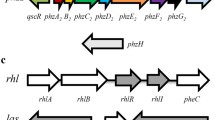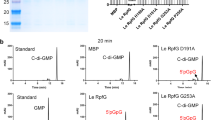Abstract
Strain Pseudomonas chlororaphis 449, an antagonist of a broad spectrum of phytopathogenic microorganisms isolated from the maize rhizosphere, was shown to produce three phenazine antibiotics: phenazine-1-carboxylic acid (PCA), 2-hydroxylphenazine-1-carboxylic acid (2-OH-PCA), and 2-hydroxylphenazine (2-OH-PHZ). Two Quorum Sensing (QS) systems of regulation were identified: Phz/R and CsaI/R. Genes phzI and csaI were cloned and sequenced. Cells of strain 449 synthesize at least three types of AHL: N-butanoyl-L-homoserine lactone (C4-AHL), N-hexanoyl-L-homoserine lactone (C6-AHL), and N-(3-oxo-hexanoyl)-L-homoserine lactone (30C6-AHL). Transposon mutagenesis was used to generate mutants of strain 449 deficient in synthesis of phenazines, which carried inactivated phzA and phzB genes of the phenazine operon and gene phzO. Mutations phzA − and phzB − caused a drastic reduction in the antagonistic activity of bacteria toward phytopathogenic fungi. Both mutants lost the ability to protect cucumber and leguminous plants against phytopathogenic fungi Rhizoctonia solani and Sclerotinia sclerotiorum. These results suggest a significant role of phenazines in the antagonistic activity of P. chlororaphis 449.
Similar content being viewed by others
References
Miller, M.B. and Bassler, B.L., Quorum Sensing in Bacteria, Annu. Rev. Microbiol., 2001, vol. 55, pp. 165–199.
Waters, C. and Bassler, B., Quorum Sensing: Cell-to-Cell Communication in Bacteria, Annu. Rev. Cell Dev. Biol., 2005, vol. 21, pp. 319–346.
Khmel, I.A. and Metlitskaya, A.Z., Quorum Sensing Regulation of Gene Expression: A Promising Target for Drugs against Bacterial Pathogenicity, Mol. Biol. (Moscow), 2006, vol. 40, pp. 195–210.
Khmel, I.A., Quorum Sensing Regulation of Gene Expression: Fundamental and Applied Aspects and the Role in Bacterial Communication, Mikrobiologiya, 2006, vol. 75, pp. 457–464.
Venturi, V., Regulation of Quorum Sensing in Pseudomonas, FEMS Microbiol. Rev., 2006, vol. 30, pp. 274–291.
Thomashow, L.S. and Weller, D.M., Current Concepts in the Use of Introduced Bacteria for Biological Disease Control: Mechanisms and Antifungal Metabolites, Plant-Microbe Interactions, Stacy and Keen, Eds., vol. 1, 1995, pp. 187–235.
Mavrodi, D.V., Ksenzenko, V.N., Bonsall, R.F., et al., A Seven-Gene Locus for Synthesis of Phenazine-1-Carboxylic Acid by Pseudomonas fluorescens 2–79, J. Bacteriol., 1998, vol. 180, pp. 2541–2548.
Delaney, S., Mavrodi, D., Bonsall, R., and Thomashow, L., phzO, a Gene for Biosynthesis of 2-Hydroxylated Phenazine Compounds in Pseudomonas aureofaciens 30–84, J. Bacteriol., 2001, vol. 183, pp. 318–327.
Wood, D.W., Gong, F., Daykin, M.M., et al., N-Acyl-Homoserine Lactone-Mediated Regulation of Phenazine Gene Expression by Pseudomonas aureofaciens 30–84 in the Wheat Rhizosphere, J. Bacteriol., 1997, vol. 179, pp. 7663–7670.
Zhang, Z. and Pierson III, L.S., A Second Quorum-Sensing System Regulates Cell Surface Properties but not Phenazine Antibiotic Production in Pseudomonas aureofaciens, Appl. Environ. Microbiol., 2001, vol. 67, pp. 4305–4315.
McClean, K.H., Winson, M.K., Fish, L., et al., Quorum Sensing in Chromobacterium violaceum: Exploitation of Violacein Production and Inhibition for the Detection of N-Acylhomoserine Lactones, Microbiology, 1997, vol. 143, pp. 3703–3711.
Shaw, P.D., Ping, G., Daly, S.L., et al., Detecting and Characterizing N-Acylhomoserine Lactone Signal Molecules by Thin-Layer Chromatography, Proc. Natl. Acad. Sci. USA, 1997, vol. 94, pp. 6036–6041.
De Lorenzo, V. and Timmis, K.N., Analysis and Construction of Stable Phenotypes in Gram-Negative Bacteria with Tn5- and Tn10-Derived Minitransposons, Methods Enzymol., 1994, vol. 235, pp. 386–405.
Winson, M.R., Swift, S., Fish, L., et al., Construction and Analysis of luxCDABE-Based Plasmid Sensors for Investigating N-Acylhomoserine Lactone-Mediated Quorum Sensing, FEMS Microbiol. Lett., 1998, vol. 163, pp. 185–192.
Hoang, T., Karkhoff-Schweizer, R., Kutchma, A., and Schweizer, H., A Broad-Host-Range Flp-FRT Recombination System for Site-Specific Excision of Chromosomally-Located DNA Sequences, Application for Isolation of Unmarked Pseudomonas aeruginosa Mutants, Gene, 1998, vol. 212, pp. 77–86.
Dennis, J.J. and Zylstra, G.J., Plasposons: Modular Self-Cloning Minitransposon Derivatives for Rapid Genetic Analysis of Gram-Negative Bacterial Genomes, Appl. Environ. Microbiol., 1998, vol. 64, pp. 2710–2715.
Vieira, J. and Messing, J., The pUC Plasmids, an M13mp7-Derived System for Insertion Mutagenesis and Sequencing with Synthetic Universal Primers, Gene, 1982, vol. 19, pp. 259–268.
Miller, J.H., Experiments in Molecular Genetics, Cold Spring Harbor: Cold Spring Harbor Laboratories, 1972.
Schweizer, H., Allelic Exchange in Pseudomonas aeruginosa Using Novel ColE1-Type Vectors and a Family of Cassettes Containing a Portable oriT and the Counter-Selectable Bacillus subtilis sacB Marker, Mol. Microbiol., 1992, vol. 6, pp. 1195–1204.
Kamensky, M., Ovadis, M., Chet, I., and Chernin, L., Soil-Borne Strain IC14 of Serratia plymuthica with Multiple Mechanisms of Antifungal Activity Provides Biocontrol of Botrytis cinerea and Sclerotinia sclerotiorum Diseases, Soil Biol. Biochem., 2003, vol. 35, pp. 323–331.
Veselova, M., Kholmeckaya, M., Klein, S., et al., Production of N-Acylhomoserine Lactone Signal Molecules by Gram-Negative Soil-Borne and Plant-Associated Bacteria, Folia Microbiol., 2003, vol. 48, pp. 794–798.
Pierson, L.S., Keppenne, V.D., and Wood, D.W., Phenazine Antibiotic Biosynthesis in Pseudomonas aureofaciens 30–84 Is Regulated by PhzR in Response to Cell Density, J. Bacteriol., 1994, vol. 176, pp. 3966–3974.
Wood, D.W. and Pierson, L.S., III, The phzI Gene of Pseudomonas aureofaciens 30–84 Is Responsible for the Production of a Diffusible Signal Required for Phenazine Antibiotic Production, Gene, 1996, vol. 168, pp. 49–53.
Smirnov, V.V. and Kiprianova, E.A., Bakterii roda Pseudomonas (Bacteria of the Genus Pseudomonas), Kiev: Naukova Dumka, 1990.
Chin-A-Woeng T., Bloemberg G., Van der Bij A., et al. Biocontrol by Phenazine-1-Carboxamide Producing Bacterium Pseudomonas chlororaphis PCL1391 of Tomato Root Rot Caused by Fusarium oxysporum f. sp. radicis-lycopersic, Mol. Plant-Microb. Interact., 1998, vol. 11, pp. 1069–1077.
Wei, J., Tsai, Y., Horng, Y., et al., A Mobile Quorum-Sensing System in Serratia marcescens, J. Bacteriol., 2006, vol. 188, pp. 1518–1525.
Mazzola, M., Cook, R., Thomashow, L., et al., Contribution of Phenazine Antibiotic Biosynthesis to the Ecological Competence of Fluorescent Pseudomonads in Soil Habitats, Appl. Environ. Microbiol., 1992, vol. 58, pp. 2616–2624.
Author information
Authors and Affiliations
Corresponding author
Additional information
Original Russian Text © M.A. Veselova, Sh. Klein, I.A. Bass, V.A. Lipasova, A.Z. Metlitskaya, M.I. Ovadis, L.S. Chernin, I.A. Khmel, 2008, published in Genetika, 2008, Vol. 44, No. 12, pp. 1617–1626.
An erratum to this article can be found at http://dx.doi.org/10.1134/S1022795409090178
Rights and permissions
About this article
Cite this article
Veselova, M.A., Klein, S., Bass, I.A. et al. Quorum sensing systems of regulation, synthesis of phenazine antibiotics, and antifungal activity in rhizospheric bacterium pseudomonas chlororaphis 449. Russ J Genet 44, 1400–1408 (2008). https://doi.org/10.1134/S102279540812003X
Received:
Published:
Issue Date:
DOI: https://doi.org/10.1134/S102279540812003X




